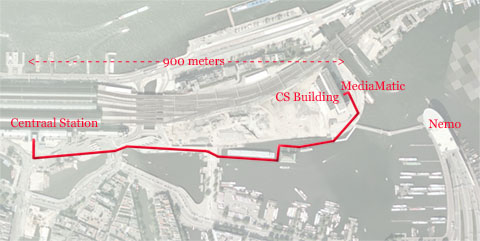
|
Landscape and sky, drifting clouds, flights of birds, flowing rivers, waving trees, the spectacle of sunset and sunrise, the span of twinkling stars, human and animal silhouettes over the horizon, all these might have been inspiration sources for the picture scroll. Raked sand, undulating cave walls, animal hides, tree bark, long leaves, battered fibers, woven threads, slabs of clay, wood and stone; all became carriers of information. Banners, buildings, impressions, paintings, scratchings, carvings, tapestry, frescos and friezes made the eye wonder and the spectator wander. Over time these information surfaces concatenated into vast picture trajectories on the walls of temple complexes, palaces and public buildings.
'Pompe', parades, processions and dances with iconographic objects carried around: banners, flags, statues and shrines lifted on shoulders. This physical and spatial 'promenade' became the subject of all sorts of linear visual representations, from simple circular scenes on pottery to combined picture and text stories on fibre materials and sculpted and painted sagas fixed in friezes and frescos. Strolling & Scrolling are two ways of animating a continuous series of signs and pictures into a story. It is either the spectator that moves along the images or the other way around: a pilgrim walking and "reading" for days along the friezes of temples; be it Angkor Watt in Cambodia, or the Borobuddor in Java. The faithful reading bible stories from the frescos on the walls and ceilings of European churches. An Asiatic scholar unrolling a scroll with one hand and rolling it with the other, thus bringing into view a shifting poetic landscape of pictures and signs. The narrator of the Indonesian Wayang Beber, who shows, sings and tells a painting on a roll to his audience. |
A congregation of citizens of the French town of Bayeux witnessing in their church the yearly unrolling of seventy meters of embroidered tapestry depicting a historical battle.
Visual narrative media stem from stories, and, are also memory devices that keep these stories alive. Some of them need a mediator: a shaman, priest, dalang, bhopo, benshi, Bänkelsänger, cantastorie, or other story singers and tellers, narrators and explicators. The original meaning of certain visual narratives may have been lost, though there are attempts to reconstruct something of their original message. Apart from that, there is always the personal and independent eye and mind of the beholder. Most tourists who visit temples, churches and other sacral sites, will use their own intuition, make up their own stories while taking in a 'visual narrative'. Reversing our historical perspective on visual and narrative media, looking back from the present day digital immersive environment, the CAVE (Cave Automatic Virtual Environment), to the natural underground void of our forebears, one can discover conceptual analogies: the potter wheel and cinematic animation; paper scrolls and the panning movement in movies; harmonica like book pages and mechanical reproduction of sound; the reflection in water and optical devices of magic mirror, anamorphosis and camera obscura... This visual lecture will attempt to give a concise overview of all these associations, linkages and some of the entertaining side stories that go with them. tj. 28/9/2006 |
| Short biography Tjebbe van Tijen: Educated as a visual artist in the early sixties. Experiments with expanded cinema, inflatables and other public events in Amsterdam, Rotterdam, The Hague and London in the mid sixties. Initiative for a documentation center on art, technology and society at the Sigma Center and Stedelijk Museum (1967-1969) and later founder and curator of the Documentation Center of Modern Social Movements at the University Library and International Institute for Social History in Amsterdam (1973-1998). Collaborative multimedia art projects mostly on historical subjects from the mid eighties onward with Jeffrey Shaw, Milos Vojectechovsky, Rolf Pixley, Fred Gales shown a.o. in Linz, Karlsruhe, Prague, Amsterdam and Tokyo. Works since 1988 under the name Imaginary Museum Projects. regular lectures, performances and publications on subjects like social memory, psycho-geography, media history, mapping of human violence and visual language. For more details see full CV. |
 |